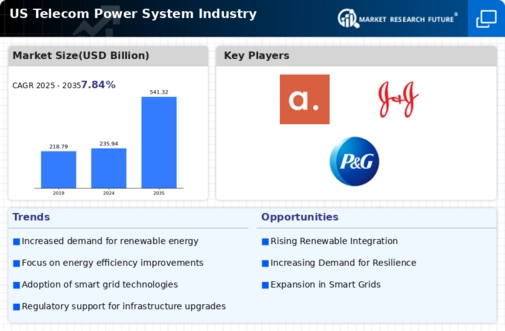Rising Demand for Data Services
The increasing demand for data services in the telecom power-system market is driven by the proliferation of smartphones and IoT devices. As consumers and businesses rely more on data-intensive applications, telecom operators are compelled to enhance their infrastructure. This necessitates robust power systems to support the growing network load. In 2025, the data traffic in the US is projected to reach 30 exabytes per month, indicating a substantial increase from previous years. Consequently, telecom companies are investing heavily in power systems to ensure reliability and efficiency, which is likely to propel growth in the telecom power-system market.
Regulatory Compliance and Standards
Regulatory compliance plays a crucial role in shaping the telecom power-system market. The US government has established stringent standards for energy efficiency and emissions, compelling telecom operators to adopt advanced power systems. Compliance with these regulations not only mitigates environmental impact but also enhances operational efficiency. For instance, the Energy Policy Act mandates specific energy-saving measures, which could lead to a reduction in operational costs by up to 20%. As telecom companies strive to meet these standards, the demand for innovative power solutions is expected to rise, thereby driving growth in the telecom power-system market.
Technological Advancements in Power Systems
Technological advancements are significantly influencing the telecom power-system market. Innovations such as high-efficiency rectifiers and advanced power management systems are enhancing the performance and reliability of telecom networks. These technologies enable operators to optimize energy consumption, which is increasingly critical as energy costs rise. In 2025, the market for energy-efficient power systems is anticipated to grow by 15%, reflecting the industry's shift towards more sustainable practices. As telecom companies adopt these cutting-edge solutions, the telecom power-system market is likely to experience substantial growth.
Focus on Sustainability and Energy Efficiency
Sustainability and energy efficiency are becoming paramount in the telecom power-system market. As environmental concerns rise, telecom operators are increasingly prioritizing green initiatives. This shift is evident in the adoption of renewable energy sources and energy-efficient technologies. In 2025, it is estimated that 40% of telecom power systems will incorporate renewable energy solutions, reflecting a significant transformation in the industry. By focusing on sustainability, telecom companies not only reduce their carbon footprint but also enhance their brand image, which is likely to drive further growth in the telecom power-system market.
Increased Investment in Network Infrastructure
The telecom power-system market is witnessing increased investment in network infrastructure, driven by the need for enhanced connectivity and service quality. With the rollout of 5G technology, telecom operators are expanding their networks, which requires substantial power resources. In 2025, investments in telecom infrastructure in the US are projected to exceed $100 billion, highlighting the urgency for reliable power systems. This surge in investment is expected to create opportunities for power system providers, thereby stimulating growth in the telecom power-system market.













Leave a Comment